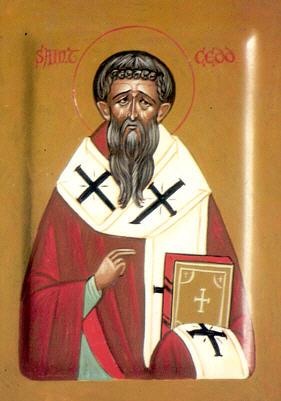The 26th October is St Cedd’s day. It is also known as Essex Day as St Cedd is Essex’s very own patron saint. Bur who is St Cedd? And why is he held in such high esteem in Essex? Archive Assistant, Robert Lee takes a look at the life of St Cedd.
St Cedd – A Hagiography

Icon of St Cedd
Cedd’s life began in the Kingdom of Northumbria under the tutelage of Saint Aidan of Lindisfarne. The oldest of four brothers (Chad, Cynibil & Caelin), Cedd in particular would be unwavering to the Celtic Rite imbued to him by Aidan. Cedd’s introduction to Christianity was anti-diocesan: not liturgical and parochial, but peripatetic and abstinent. In one of very few sources on Cedd, the Venerable Bede’s Ecclesiastical History of the English People, emphasis is made on both Cedd and Chad’s devotion to Saint Aidan; such that four years after Aidan’s death in 651, Cedd is said to have been consecrated by the hands of his successor, Saint Finan of Lindisfarne.
Cedd’s reputation in Christendom had much to do with his proselytizing. In 653, at the behest of King Oswiu of Northumbria, Cedd journeyed into the Midlands with three other priests in order to evangelise the “Middle Angles”: an ethnic group predominantly living in Mercia. By Bede’s account, Cedd was greatly persuasive, with masses coming forward to listen to his preaching and receive baptism. Cedd’s enthusiasm would even sway the opinion of King Penda of Mercia, a long committed pagan. Later in the same year, Cedd would be recalled from Mercia and sent into Essex to aid King Sigeberht of the East Saxons. Again Cedd’s evangelism was highly successful, and Essex was thoroughly Christianised. For his efforts Cedd was ordained Bishop of the East Saxons.
Cedd attended the Synod of Whitby in 664 as a vigilant mediator between Iona (followers of the Celtic Rite) and those who followed the Roman Rite. Roman missionaries were arguing for their own computation of the calendar day of Easter, to which the predominantly Celtic northern English initially disagreed. Uncharacteristically, Cedd was won over by the catholic system, and converted to the Alexandrian computus of Easter Sunday. Following the Synod, Cedd returned to Northumbria to supervise the foundation of a monastery, but the Kingdom had been overwhelmed by the yellow plague, which would bring about Cedd’s death.

St Peters-on-the-wall in November (Copyright Edward Harris)
Perhaps appropriately, Cedd is remembered far more for his itinerant sainthood than for government of the East Saxon Church. The chapel of Saint-Peter-on-the-Wall in Bradwell-on-Sea is said to have been built by Saint Cedd after his ordination. Having gone through several phases of disuse and ruination, the chapel still stands as testimony to Cedd; to God’s glory and the humility of man.
His role in converting the East Saxons and role as their bishop is the reason that Essex now claims Cedd as their patron saint.
If you would like to visit the Chapel of St Peter yourself it can be reached by taking East End Road from the brick built church in Bradwell-on-Sea for about one and a half miles, until you can see the carpark ahead of you, from there it is a ten minute walk to the Chapel. It is open all year and is well worth a visit!
